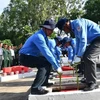Vietnam must better prepare for earthquakes, a conference in Hanoi heard on March 29.
According to scientists at the event organised by the Institute of Geophysics, the country could be severely affected by earthquakes and tsunamis.
Geophysics Institute associate professor Cao Dinh Trieu, who is second vice president of the Asian Seismological Committee, said a 5.3 magnitude earthquake on the Vietnam-Laos border in 2001 damaged 98 percent of offices and schools and injured two people in Dien Bien city.
"The earthquake was average in terms of magnitude and occurred 10km away from Dien Bien but its devastation was huge," he said.
Earthquakes of similar size in countries such as Japan or Indonesia by contrast had a nominal effect, he said.
The scientist blamed low quality building work in Vietnam and inadequate public awareness.
Professor Bui Cong Que, Director of the Geophysics Institute shared the opinion.
"Raising public awareness and issuing stricter earthquake and tsunami-proof construction regulations is an urgent task," he said.
Deputy Director of Earthquake and Tsunami Warning Centre Nguyen Hong Phuong also said readiness is the most important factor as no country in the world so far could forecast exactly when an earthquake would occur.
Important lessons had been learned internationally. The magnitude 8.8 Chilean earthquake last year was much stronger than the one that hit Haiti, but the number of casualties and damage was far less. Experts also said Japan's preparedness had saved a lot of lives.
A recent report released by the United Nations shows Vietnam is much less vulnerable to earthquakes than other countries in the region as it is not located on the edge of any tectonic plate.
But in the northern region, fault systems such as the Red River, the Ma River and the Lai Chau-Dien Bien area could have lengths of several hundred kilometres and slip rates in the range of 0.5-2mm a year, which potentially generate earthquakes from 5.7 to 7 magnitude.
Associate professor Trieu said earthquakes in Vietnam usually had epicentres close to the surface, resulting in higher intensity shaking at ground level.
Deputy Director of the Geophysics Institute Le Huy Minh said the geological foundation of many places in Vietnam was quite weak, which would add to the shaking produced by earthquakes.
Trieu said strong earthquakes had been recorded by seismographs in Vietnam since 1924.
The most recent magnitude 6.8 and 6.7 earthquakes had occurred in Dien Bien Phu and Tuan Giao, both in the northern province of Dien Bien, in 1935 and 1986.
The quakes killed and injured dozens of people, destroyed houses and caused cracks of up to 20km long on the ground.
Two earthquakes with magnitude 5.6-6.0, 13 with magnitude 5.1-5.5 and more than 100 others with magnitude 4.6-5.0 have also occurred in Vietnam in the last 90 years.
Another 108 strong earthquakes have been recorded in the country since 114AD with up to 18 recorded in Hanoi, according to Trieu.
The scientist said there were signs of seismic quietness, or a temporary quiet period after a strong seismic activation span, in the capital city.
"Earthquakes in Hanoi historically were not weak at all but over a prolonged period, not a single sign of seismic activity has been recorded. It's worrying!" he said.
The signs of an active period after a seismic pause in the southern centre and the south of Vietnam with more and more frequent earthquakes of over magnitude 3.0 since 2000 also needed attention, said Trieu.
Meanwhile, scientists said the central coast from Quang Tri Province to Ninh Thuan Province could potentially be the most affected by tsunamis although the probability of a tsunami in Vietnam was low.
In case of an 8.6 magnitude earthquake at Manila Trench in the East Sea, west of the Philippines, this area could suffer tsunamis of 8-10m after about two hours.
If a 9 magnitude earthquake occured in the zone, central Nha Trang City will be 6-7m under the water and more than 19,000 people may be killed, according to the latest research conducted by the Geophysics Institute.
Professor Que said two other likely sources of earthquakes that could trigger tsunamis reaching the Vietnamese coast included faults in the northern area of the East Sea and along the central coast.
"Therefore, the possibility of earthquakes and tsunamis must be taken into account before erecting any plants and buildings along the coast," he said. /.
According to scientists at the event organised by the Institute of Geophysics, the country could be severely affected by earthquakes and tsunamis.
Geophysics Institute associate professor Cao Dinh Trieu, who is second vice president of the Asian Seismological Committee, said a 5.3 magnitude earthquake on the Vietnam-Laos border in 2001 damaged 98 percent of offices and schools and injured two people in Dien Bien city.
"The earthquake was average in terms of magnitude and occurred 10km away from Dien Bien but its devastation was huge," he said.
Earthquakes of similar size in countries such as Japan or Indonesia by contrast had a nominal effect, he said.
The scientist blamed low quality building work in Vietnam and inadequate public awareness.
Professor Bui Cong Que, Director of the Geophysics Institute shared the opinion.
"Raising public awareness and issuing stricter earthquake and tsunami-proof construction regulations is an urgent task," he said.
Deputy Director of Earthquake and Tsunami Warning Centre Nguyen Hong Phuong also said readiness is the most important factor as no country in the world so far could forecast exactly when an earthquake would occur.
Important lessons had been learned internationally. The magnitude 8.8 Chilean earthquake last year was much stronger than the one that hit Haiti, but the number of casualties and damage was far less. Experts also said Japan's preparedness had saved a lot of lives.
A recent report released by the United Nations shows Vietnam is much less vulnerable to earthquakes than other countries in the region as it is not located on the edge of any tectonic plate.
But in the northern region, fault systems such as the Red River, the Ma River and the Lai Chau-Dien Bien area could have lengths of several hundred kilometres and slip rates in the range of 0.5-2mm a year, which potentially generate earthquakes from 5.7 to 7 magnitude.
Associate professor Trieu said earthquakes in Vietnam usually had epicentres close to the surface, resulting in higher intensity shaking at ground level.
Deputy Director of the Geophysics Institute Le Huy Minh said the geological foundation of many places in Vietnam was quite weak, which would add to the shaking produced by earthquakes.
Trieu said strong earthquakes had been recorded by seismographs in Vietnam since 1924.
The most recent magnitude 6.8 and 6.7 earthquakes had occurred in Dien Bien Phu and Tuan Giao, both in the northern province of Dien Bien, in 1935 and 1986.
The quakes killed and injured dozens of people, destroyed houses and caused cracks of up to 20km long on the ground.
Two earthquakes with magnitude 5.6-6.0, 13 with magnitude 5.1-5.5 and more than 100 others with magnitude 4.6-5.0 have also occurred in Vietnam in the last 90 years.
Another 108 strong earthquakes have been recorded in the country since 114AD with up to 18 recorded in Hanoi, according to Trieu.
The scientist said there were signs of seismic quietness, or a temporary quiet period after a strong seismic activation span, in the capital city.
"Earthquakes in Hanoi historically were not weak at all but over a prolonged period, not a single sign of seismic activity has been recorded. It's worrying!" he said.
The signs of an active period after a seismic pause in the southern centre and the south of Vietnam with more and more frequent earthquakes of over magnitude 3.0 since 2000 also needed attention, said Trieu.
Meanwhile, scientists said the central coast from Quang Tri Province to Ninh Thuan Province could potentially be the most affected by tsunamis although the probability of a tsunami in Vietnam was low.
In case of an 8.6 magnitude earthquake at Manila Trench in the East Sea, west of the Philippines, this area could suffer tsunamis of 8-10m after about two hours.
If a 9 magnitude earthquake occured in the zone, central Nha Trang City will be 6-7m under the water and more than 19,000 people may be killed, according to the latest research conducted by the Geophysics Institute.
Professor Que said two other likely sources of earthquakes that could trigger tsunamis reaching the Vietnamese coast included faults in the northern area of the East Sea and along the central coast.
"Therefore, the possibility of earthquakes and tsunamis must be taken into account before erecting any plants and buildings along the coast," he said. /.



















